Qantas Airline: Case Study, Financial Performance and Strategies
VerifiedAdded on 2020/02/24
|10
|2944
|244
Report
AI Summary
This report offers a comprehensive analysis of Qantas airline, examining its strategies, financial performance, and competitive forces. It begins with an executive summary and an introduction that outlines the report's objectives. The paper then delves into the competitive landscape, analyzing the five forces that shape Qantas's strategy, including the threat of new entrants, substitute products, and bargaining power of suppliers and buyers. A SWOT analysis is conducted to identify the airline's strengths, weaknesses, opportunities, and threats. The report explores Qantas's various strategies, including cost leadership, brand reputation, and differentiation, with a focus on its subsidiaries and differentiated product offerings. The report also analyzes the airline's depreciation and revenue recognition policies. Finally, the report provides a detailed comparison of Qantas's financial performance in 2013 and 2016, examining revenue, profit, assets, liabilities, and cash flow, and the factors that influenced these changes.
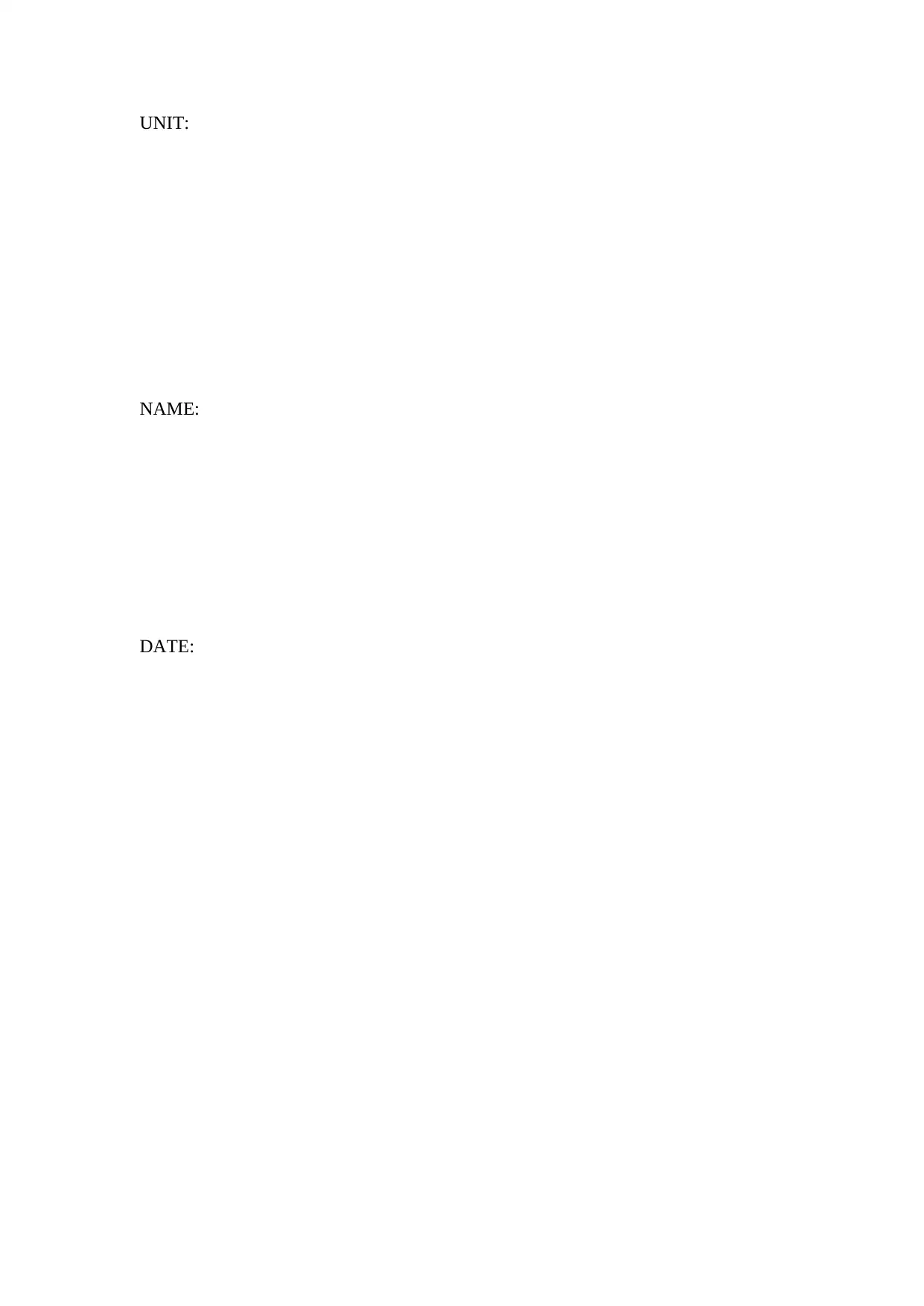
UNIT:
NAME:
DATE:
NAME:
DATE:
Paraphrase This Document
Need a fresh take? Get an instant paraphrase of this document with our AI Paraphraser
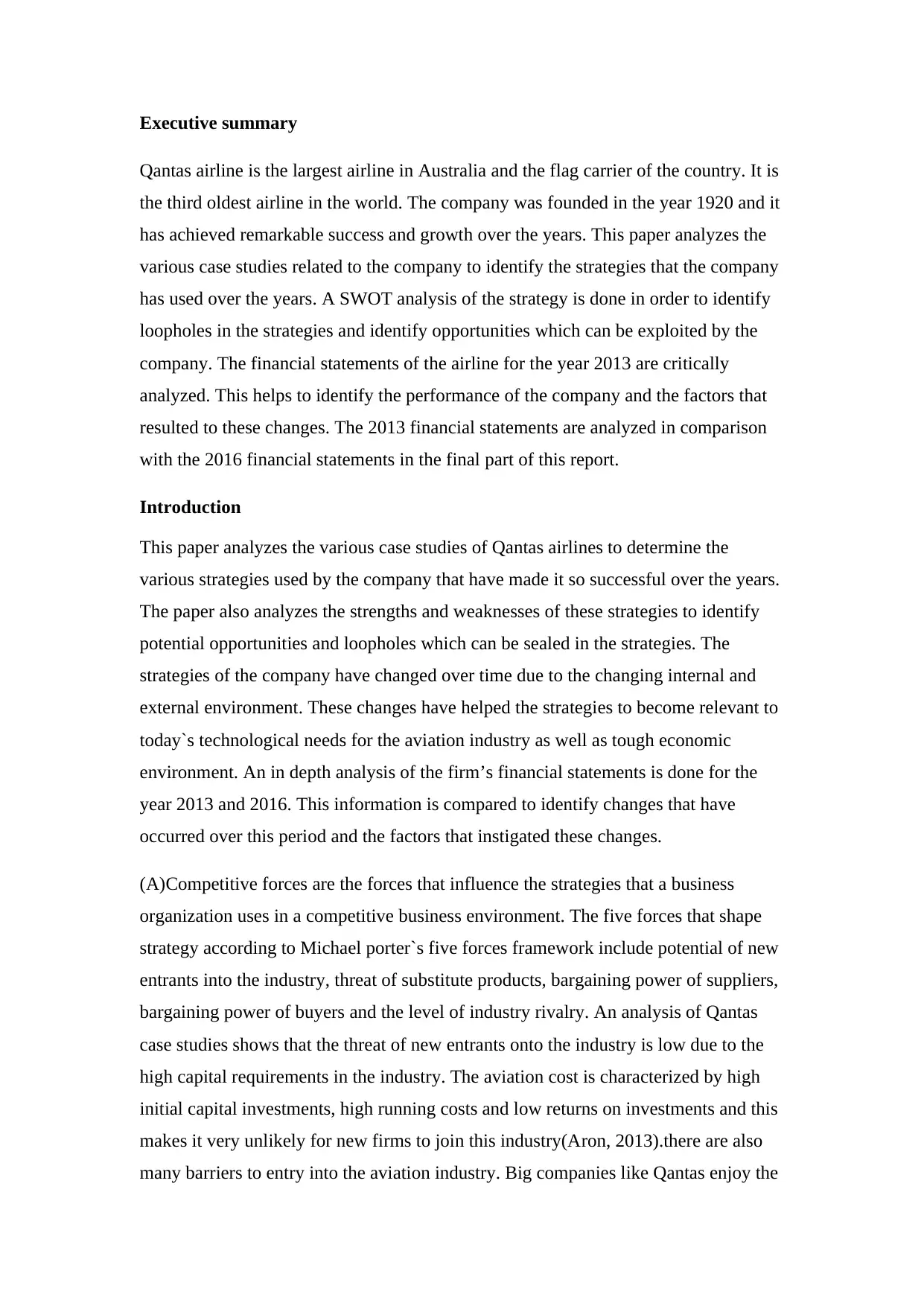
Executive summary
Qantas airline is the largest airline in Australia and the flag carrier of the country. It is
the third oldest airline in the world. The company was founded in the year 1920 and it
has achieved remarkable success and growth over the years. This paper analyzes the
various case studies related to the company to identify the strategies that the company
has used over the years. A SWOT analysis of the strategy is done in order to identify
loopholes in the strategies and identify opportunities which can be exploited by the
company. The financial statements of the airline for the year 2013 are critically
analyzed. This helps to identify the performance of the company and the factors that
resulted to these changes. The 2013 financial statements are analyzed in comparison
with the 2016 financial statements in the final part of this report.
Introduction
This paper analyzes the various case studies of Qantas airlines to determine the
various strategies used by the company that have made it so successful over the years.
The paper also analyzes the strengths and weaknesses of these strategies to identify
potential opportunities and loopholes which can be sealed in the strategies. The
strategies of the company have changed over time due to the changing internal and
external environment. These changes have helped the strategies to become relevant to
today`s technological needs for the aviation industry as well as tough economic
environment. An in depth analysis of the firm’s financial statements is done for the
year 2013 and 2016. This information is compared to identify changes that have
occurred over this period and the factors that instigated these changes.
(A)Competitive forces are the forces that influence the strategies that a business
organization uses in a competitive business environment. The five forces that shape
strategy according to Michael porter`s five forces framework include potential of new
entrants into the industry, threat of substitute products, bargaining power of suppliers,
bargaining power of buyers and the level of industry rivalry. An analysis of Qantas
case studies shows that the threat of new entrants onto the industry is low due to the
high capital requirements in the industry. The aviation cost is characterized by high
initial capital investments, high running costs and low returns on investments and this
makes it very unlikely for new firms to join this industry(Aron, 2013).there are also
many barriers to entry into the aviation industry. Big companies like Qantas enjoy the
Qantas airline is the largest airline in Australia and the flag carrier of the country. It is
the third oldest airline in the world. The company was founded in the year 1920 and it
has achieved remarkable success and growth over the years. This paper analyzes the
various case studies related to the company to identify the strategies that the company
has used over the years. A SWOT analysis of the strategy is done in order to identify
loopholes in the strategies and identify opportunities which can be exploited by the
company. The financial statements of the airline for the year 2013 are critically
analyzed. This helps to identify the performance of the company and the factors that
resulted to these changes. The 2013 financial statements are analyzed in comparison
with the 2016 financial statements in the final part of this report.
Introduction
This paper analyzes the various case studies of Qantas airlines to determine the
various strategies used by the company that have made it so successful over the years.
The paper also analyzes the strengths and weaknesses of these strategies to identify
potential opportunities and loopholes which can be sealed in the strategies. The
strategies of the company have changed over time due to the changing internal and
external environment. These changes have helped the strategies to become relevant to
today`s technological needs for the aviation industry as well as tough economic
environment. An in depth analysis of the firm’s financial statements is done for the
year 2013 and 2016. This information is compared to identify changes that have
occurred over this period and the factors that instigated these changes.
(A)Competitive forces are the forces that influence the strategies that a business
organization uses in a competitive business environment. The five forces that shape
strategy according to Michael porter`s five forces framework include potential of new
entrants into the industry, threat of substitute products, bargaining power of suppliers,
bargaining power of buyers and the level of industry rivalry. An analysis of Qantas
case studies shows that the threat of new entrants onto the industry is low due to the
high capital requirements in the industry. The aviation cost is characterized by high
initial capital investments, high running costs and low returns on investments and this
makes it very unlikely for new firms to join this industry(Aron, 2013).there are also
many barriers to entry into the aviation industry. Big companies like Qantas enjoy the
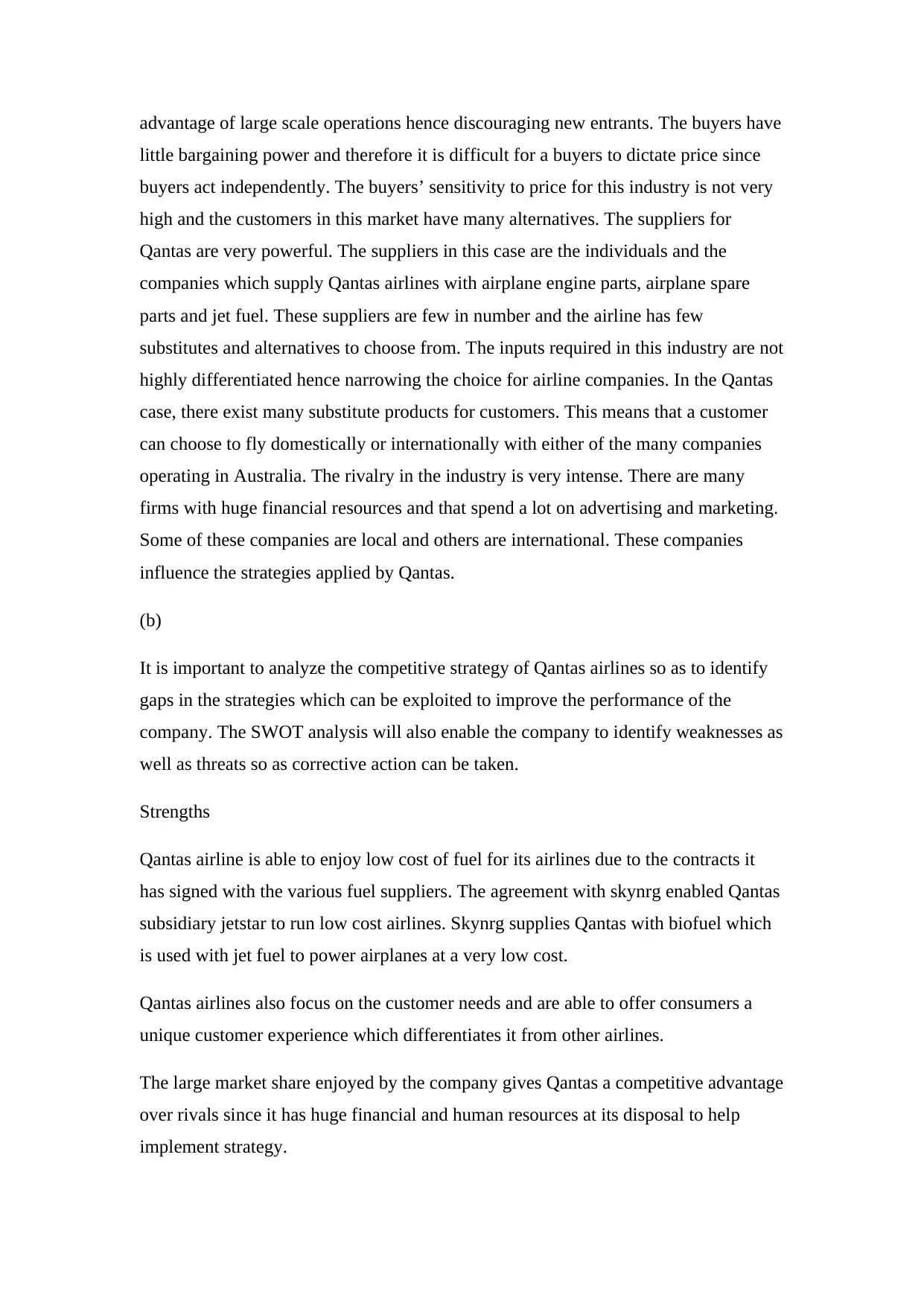
advantage of large scale operations hence discouraging new entrants. The buyers have
little bargaining power and therefore it is difficult for a buyers to dictate price since
buyers act independently. The buyers’ sensitivity to price for this industry is not very
high and the customers in this market have many alternatives. The suppliers for
Qantas are very powerful. The suppliers in this case are the individuals and the
companies which supply Qantas airlines with airplane engine parts, airplane spare
parts and jet fuel. These suppliers are few in number and the airline has few
substitutes and alternatives to choose from. The inputs required in this industry are not
highly differentiated hence narrowing the choice for airline companies. In the Qantas
case, there exist many substitute products for customers. This means that a customer
can choose to fly domestically or internationally with either of the many companies
operating in Australia. The rivalry in the industry is very intense. There are many
firms with huge financial resources and that spend a lot on advertising and marketing.
Some of these companies are local and others are international. These companies
influence the strategies applied by Qantas.
(b)
It is important to analyze the competitive strategy of Qantas airlines so as to identify
gaps in the strategies which can be exploited to improve the performance of the
company. The SWOT analysis will also enable the company to identify weaknesses as
well as threats so as corrective action can be taken.
Strengths
Qantas airline is able to enjoy low cost of fuel for its airlines due to the contracts it
has signed with the various fuel suppliers. The agreement with skynrg enabled Qantas
subsidiary jetstar to run low cost airlines. Skynrg supplies Qantas with biofuel which
is used with jet fuel to power airplanes at a very low cost.
Qantas airlines also focus on the customer needs and are able to offer consumers a
unique customer experience which differentiates it from other airlines.
The large market share enjoyed by the company gives Qantas a competitive advantage
over rivals since it has huge financial and human resources at its disposal to help
implement strategy.
little bargaining power and therefore it is difficult for a buyers to dictate price since
buyers act independently. The buyers’ sensitivity to price for this industry is not very
high and the customers in this market have many alternatives. The suppliers for
Qantas are very powerful. The suppliers in this case are the individuals and the
companies which supply Qantas airlines with airplane engine parts, airplane spare
parts and jet fuel. These suppliers are few in number and the airline has few
substitutes and alternatives to choose from. The inputs required in this industry are not
highly differentiated hence narrowing the choice for airline companies. In the Qantas
case, there exist many substitute products for customers. This means that a customer
can choose to fly domestically or internationally with either of the many companies
operating in Australia. The rivalry in the industry is very intense. There are many
firms with huge financial resources and that spend a lot on advertising and marketing.
Some of these companies are local and others are international. These companies
influence the strategies applied by Qantas.
(b)
It is important to analyze the competitive strategy of Qantas airlines so as to identify
gaps in the strategies which can be exploited to improve the performance of the
company. The SWOT analysis will also enable the company to identify weaknesses as
well as threats so as corrective action can be taken.
Strengths
Qantas airline is able to enjoy low cost of fuel for its airlines due to the contracts it
has signed with the various fuel suppliers. The agreement with skynrg enabled Qantas
subsidiary jetstar to run low cost airlines. Skynrg supplies Qantas with biofuel which
is used with jet fuel to power airplanes at a very low cost.
Qantas airlines also focus on the customer needs and are able to offer consumers a
unique customer experience which differentiates it from other airlines.
The large market share enjoyed by the company gives Qantas a competitive advantage
over rivals since it has huge financial and human resources at its disposal to help
implement strategy.
⊘ This is a preview!⊘
Do you want full access?
Subscribe today to unlock all pages.

Trusted by 1+ million students worldwide
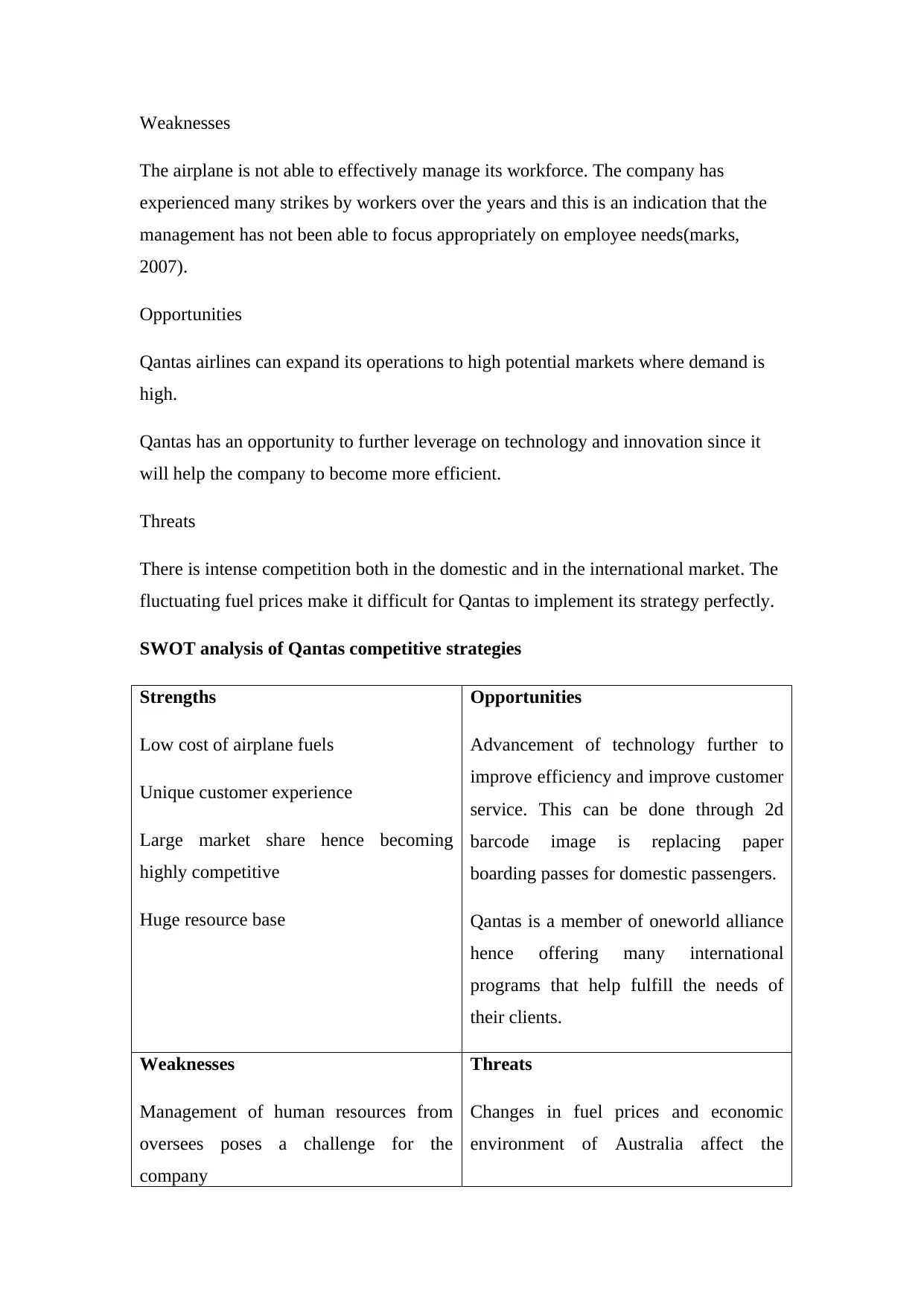
Weaknesses
The airplane is not able to effectively manage its workforce. The company has
experienced many strikes by workers over the years and this is an indication that the
management has not been able to focus appropriately on employee needs(marks,
2007).
Opportunities
Qantas airlines can expand its operations to high potential markets where demand is
high.
Qantas has an opportunity to further leverage on technology and innovation since it
will help the company to become more efficient.
Threats
There is intense competition both in the domestic and in the international market. The
fluctuating fuel prices make it difficult for Qantas to implement its strategy perfectly.
SWOT analysis of Qantas competitive strategies
Strengths
Low cost of airplane fuels
Unique customer experience
Large market share hence becoming
highly competitive
Huge resource base
Opportunities
Advancement of technology further to
improve efficiency and improve customer
service. This can be done through 2d
barcode image is replacing paper
boarding passes for domestic passengers.
Qantas is a member of oneworld alliance
hence offering many international
programs that help fulfill the needs of
their clients.
Weaknesses
Management of human resources from
oversees poses a challenge for the
company
Threats
Changes in fuel prices and economic
environment of Australia affect the
The airplane is not able to effectively manage its workforce. The company has
experienced many strikes by workers over the years and this is an indication that the
management has not been able to focus appropriately on employee needs(marks,
2007).
Opportunities
Qantas airlines can expand its operations to high potential markets where demand is
high.
Qantas has an opportunity to further leverage on technology and innovation since it
will help the company to become more efficient.
Threats
There is intense competition both in the domestic and in the international market. The
fluctuating fuel prices make it difficult for Qantas to implement its strategy perfectly.
SWOT analysis of Qantas competitive strategies
Strengths
Low cost of airplane fuels
Unique customer experience
Large market share hence becoming
highly competitive
Huge resource base
Opportunities
Advancement of technology further to
improve efficiency and improve customer
service. This can be done through 2d
barcode image is replacing paper
boarding passes for domestic passengers.
Qantas is a member of oneworld alliance
hence offering many international
programs that help fulfill the needs of
their clients.
Weaknesses
Management of human resources from
oversees poses a challenge for the
company
Threats
Changes in fuel prices and economic
environment of Australia affect the
Paraphrase This Document
Need a fresh take? Get an instant paraphrase of this document with our AI Paraphraser
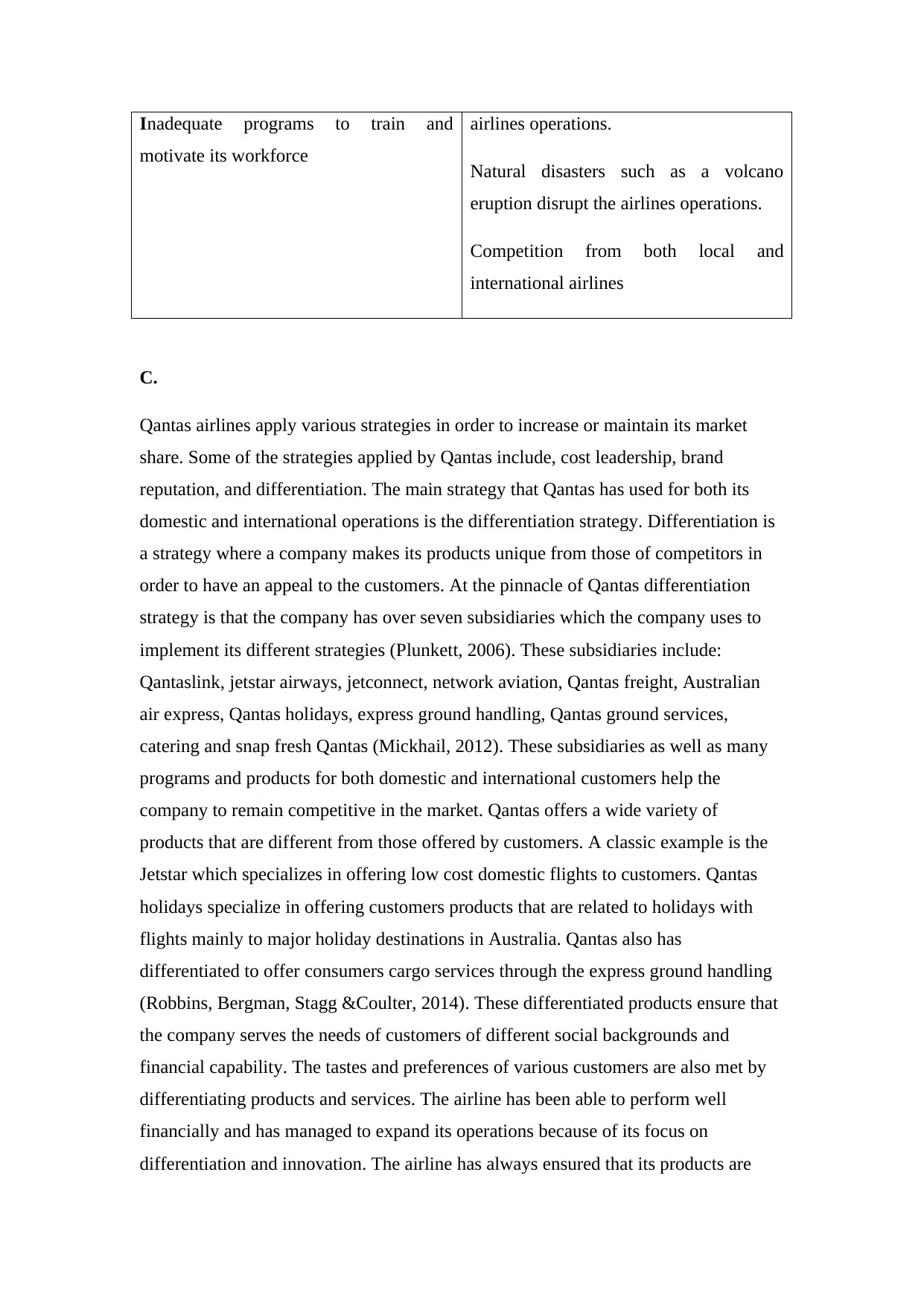
Inadequate programs to train and
motivate its workforce
airlines operations.
Natural disasters such as a volcano
eruption disrupt the airlines operations.
Competition from both local and
international airlines
C.
Qantas airlines apply various strategies in order to increase or maintain its market
share. Some of the strategies applied by Qantas include, cost leadership, brand
reputation, and differentiation. The main strategy that Qantas has used for both its
domestic and international operations is the differentiation strategy. Differentiation is
a strategy where a company makes its products unique from those of competitors in
order to have an appeal to the customers. At the pinnacle of Qantas differentiation
strategy is that the company has over seven subsidiaries which the company uses to
implement its different strategies (Plunkett, 2006). These subsidiaries include:
Qantaslink, jetstar airways, jetconnect, network aviation, Qantas freight, Australian
air express, Qantas holidays, express ground handling, Qantas ground services,
catering and snap fresh Qantas (Mickhail, 2012). These subsidiaries as well as many
programs and products for both domestic and international customers help the
company to remain competitive in the market. Qantas offers a wide variety of
products that are different from those offered by customers. A classic example is the
Jetstar which specializes in offering low cost domestic flights to customers. Qantas
holidays specialize in offering customers products that are related to holidays with
flights mainly to major holiday destinations in Australia. Qantas also has
differentiated to offer consumers cargo services through the express ground handling
(Robbins, Bergman, Stagg &Coulter, 2014). These differentiated products ensure that
the company serves the needs of customers of different social backgrounds and
financial capability. The tastes and preferences of various customers are also met by
differentiating products and services. The airline has been able to perform well
financially and has managed to expand its operations because of its focus on
differentiation and innovation. The airline has always ensured that its products are
motivate its workforce
airlines operations.
Natural disasters such as a volcano
eruption disrupt the airlines operations.
Competition from both local and
international airlines
C.
Qantas airlines apply various strategies in order to increase or maintain its market
share. Some of the strategies applied by Qantas include, cost leadership, brand
reputation, and differentiation. The main strategy that Qantas has used for both its
domestic and international operations is the differentiation strategy. Differentiation is
a strategy where a company makes its products unique from those of competitors in
order to have an appeal to the customers. At the pinnacle of Qantas differentiation
strategy is that the company has over seven subsidiaries which the company uses to
implement its different strategies (Plunkett, 2006). These subsidiaries include:
Qantaslink, jetstar airways, jetconnect, network aviation, Qantas freight, Australian
air express, Qantas holidays, express ground handling, Qantas ground services,
catering and snap fresh Qantas (Mickhail, 2012). These subsidiaries as well as many
programs and products for both domestic and international customers help the
company to remain competitive in the market. Qantas offers a wide variety of
products that are different from those offered by customers. A classic example is the
Jetstar which specializes in offering low cost domestic flights to customers. Qantas
holidays specialize in offering customers products that are related to holidays with
flights mainly to major holiday destinations in Australia. Qantas also has
differentiated to offer consumers cargo services through the express ground handling
(Robbins, Bergman, Stagg &Coulter, 2014). These differentiated products ensure that
the company serves the needs of customers of different social backgrounds and
financial capability. The tastes and preferences of various customers are also met by
differentiating products and services. The airline has been able to perform well
financially and has managed to expand its operations because of its focus on
differentiation and innovation. The airline has always ensured that its products are
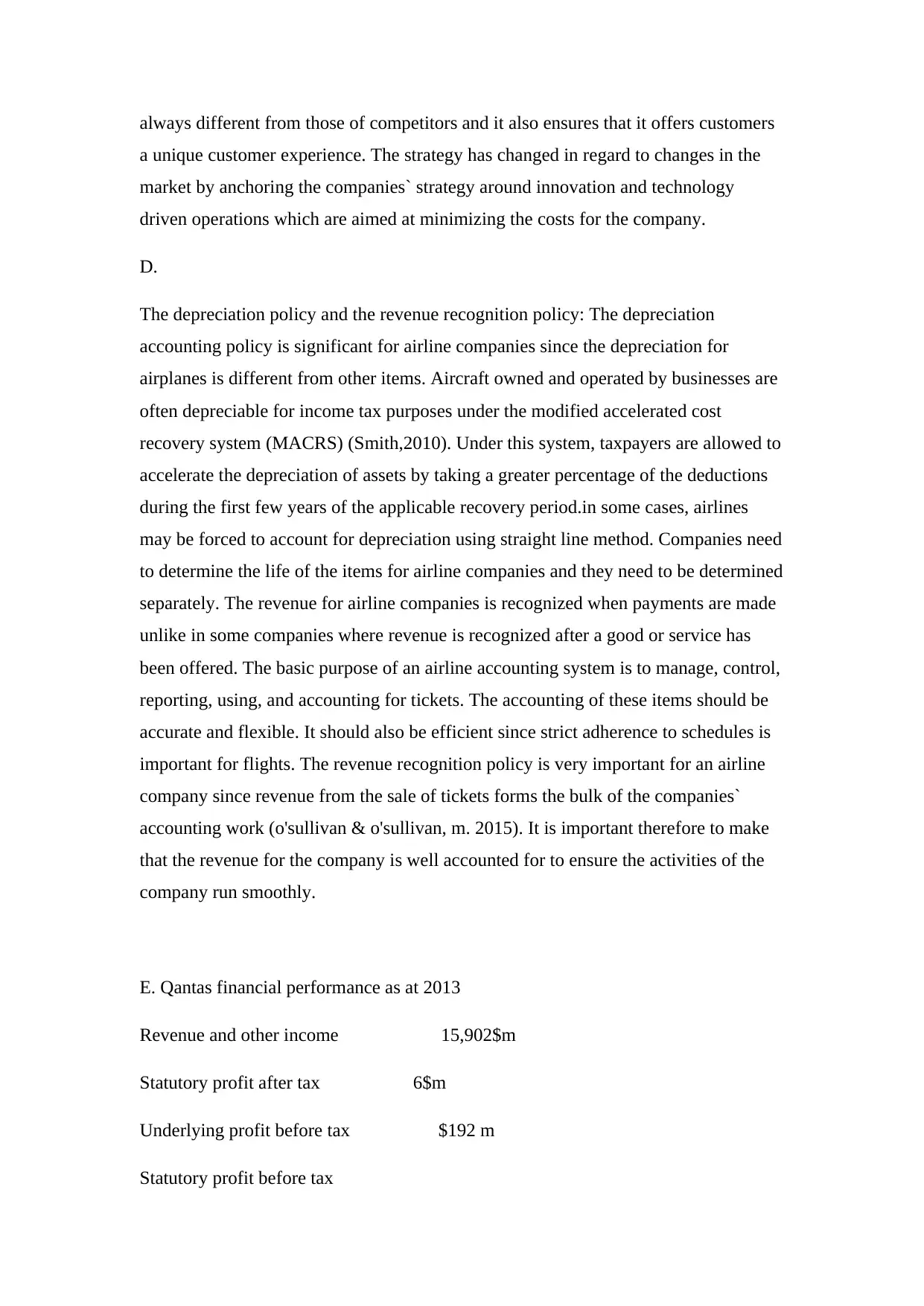
always different from those of competitors and it also ensures that it offers customers
a unique customer experience. The strategy has changed in regard to changes in the
market by anchoring the companies` strategy around innovation and technology
driven operations which are aimed at minimizing the costs for the company.
D.
The depreciation policy and the revenue recognition policy: The depreciation
accounting policy is significant for airline companies since the depreciation for
airplanes is different from other items. Aircraft owned and operated by businesses are
often depreciable for income tax purposes under the modified accelerated cost
recovery system (MACRS) (Smith,2010). Under this system, taxpayers are allowed to
accelerate the depreciation of assets by taking a greater percentage of the deductions
during the first few years of the applicable recovery period.in some cases, airlines
may be forced to account for depreciation using straight line method. Companies need
to determine the life of the items for airline companies and they need to be determined
separately. The revenue for airline companies is recognized when payments are made
unlike in some companies where revenue is recognized after a good or service has
been offered. The basic purpose of an airline accounting system is to manage, control,
reporting, using, and accounting for tickets. The accounting of these items should be
accurate and flexible. It should also be efficient since strict adherence to schedules is
important for flights. The revenue recognition policy is very important for an airline
company since revenue from the sale of tickets forms the bulk of the companies`
accounting work (o'sullivan & o'sullivan, m. 2015). It is important therefore to make
that the revenue for the company is well accounted for to ensure the activities of the
company run smoothly.
E. Qantas financial performance as at 2013
Revenue and other income 15,902$m
Statutory profit after tax 6$m
Underlying profit before tax $192 m
Statutory profit before tax
a unique customer experience. The strategy has changed in regard to changes in the
market by anchoring the companies` strategy around innovation and technology
driven operations which are aimed at minimizing the costs for the company.
D.
The depreciation policy and the revenue recognition policy: The depreciation
accounting policy is significant for airline companies since the depreciation for
airplanes is different from other items. Aircraft owned and operated by businesses are
often depreciable for income tax purposes under the modified accelerated cost
recovery system (MACRS) (Smith,2010). Under this system, taxpayers are allowed to
accelerate the depreciation of assets by taking a greater percentage of the deductions
during the first few years of the applicable recovery period.in some cases, airlines
may be forced to account for depreciation using straight line method. Companies need
to determine the life of the items for airline companies and they need to be determined
separately. The revenue for airline companies is recognized when payments are made
unlike in some companies where revenue is recognized after a good or service has
been offered. The basic purpose of an airline accounting system is to manage, control,
reporting, using, and accounting for tickets. The accounting of these items should be
accurate and flexible. It should also be efficient since strict adherence to schedules is
important for flights. The revenue recognition policy is very important for an airline
company since revenue from the sale of tickets forms the bulk of the companies`
accounting work (o'sullivan & o'sullivan, m. 2015). It is important therefore to make
that the revenue for the company is well accounted for to ensure the activities of the
company run smoothly.
E. Qantas financial performance as at 2013
Revenue and other income 15,902$m
Statutory profit after tax 6$m
Underlying profit before tax $192 m
Statutory profit before tax
⊘ This is a preview!⊘
Do you want full access?
Subscribe today to unlock all pages.

Trusted by 1+ million students worldwide
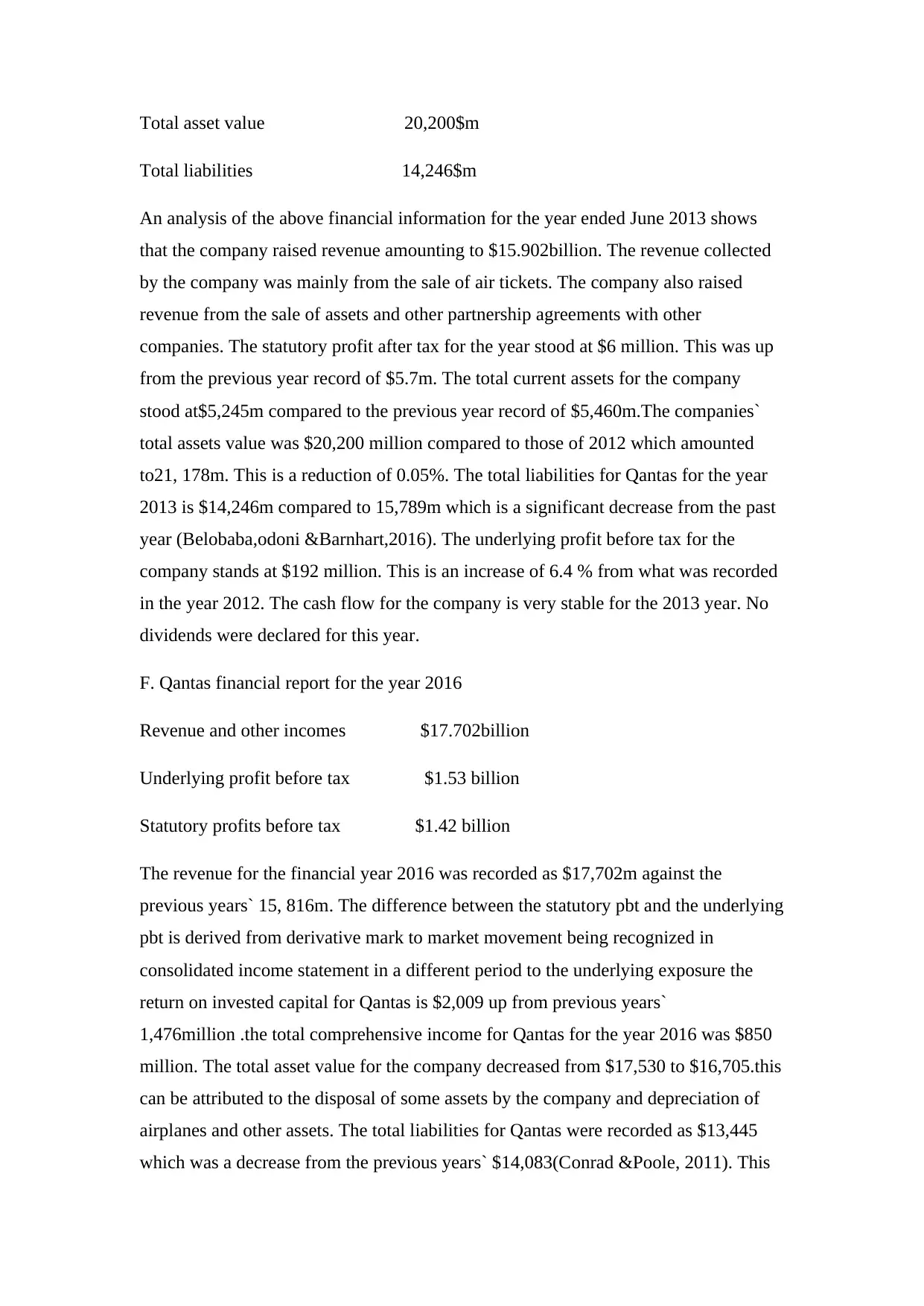
Total asset value 20,200$m
Total liabilities 14,246$m
An analysis of the above financial information for the year ended June 2013 shows
that the company raised revenue amounting to $15.902billion. The revenue collected
by the company was mainly from the sale of air tickets. The company also raised
revenue from the sale of assets and other partnership agreements with other
companies. The statutory profit after tax for the year stood at $6 million. This was up
from the previous year record of $5.7m. The total current assets for the company
stood at$5,245m compared to the previous year record of $5,460m.The companies`
total assets value was $20,200 million compared to those of 2012 which amounted
to21, 178m. This is a reduction of 0.05%. The total liabilities for Qantas for the year
2013 is $14,246m compared to 15,789m which is a significant decrease from the past
year (Belobaba,odoni &Barnhart,2016). The underlying profit before tax for the
company stands at $192 million. This is an increase of 6.4 % from what was recorded
in the year 2012. The cash flow for the company is very stable for the 2013 year. No
dividends were declared for this year.
F. Qantas financial report for the year 2016
Revenue and other incomes $17.702billion
Underlying profit before tax $1.53 billion
Statutory profits before tax $1.42 billion
The revenue for the financial year 2016 was recorded as $17,702m against the
previous years` 15, 816m. The difference between the statutory pbt and the underlying
pbt is derived from derivative mark to market movement being recognized in
consolidated income statement in a different period to the underlying exposure the
return on invested capital for Qantas is $2,009 up from previous years`
1,476million .the total comprehensive income for Qantas for the year 2016 was $850
million. The total asset value for the company decreased from $17,530 to $16,705.this
can be attributed to the disposal of some assets by the company and depreciation of
airplanes and other assets. The total liabilities for Qantas were recorded as $13,445
which was a decrease from the previous years` $14,083(Conrad &Poole, 2011). This
Total liabilities 14,246$m
An analysis of the above financial information for the year ended June 2013 shows
that the company raised revenue amounting to $15.902billion. The revenue collected
by the company was mainly from the sale of air tickets. The company also raised
revenue from the sale of assets and other partnership agreements with other
companies. The statutory profit after tax for the year stood at $6 million. This was up
from the previous year record of $5.7m. The total current assets for the company
stood at$5,245m compared to the previous year record of $5,460m.The companies`
total assets value was $20,200 million compared to those of 2012 which amounted
to21, 178m. This is a reduction of 0.05%. The total liabilities for Qantas for the year
2013 is $14,246m compared to 15,789m which is a significant decrease from the past
year (Belobaba,odoni &Barnhart,2016). The underlying profit before tax for the
company stands at $192 million. This is an increase of 6.4 % from what was recorded
in the year 2012. The cash flow for the company is very stable for the 2013 year. No
dividends were declared for this year.
F. Qantas financial report for the year 2016
Revenue and other incomes $17.702billion
Underlying profit before tax $1.53 billion
Statutory profits before tax $1.42 billion
The revenue for the financial year 2016 was recorded as $17,702m against the
previous years` 15, 816m. The difference between the statutory pbt and the underlying
pbt is derived from derivative mark to market movement being recognized in
consolidated income statement in a different period to the underlying exposure the
return on invested capital for Qantas is $2,009 up from previous years`
1,476million .the total comprehensive income for Qantas for the year 2016 was $850
million. The total asset value for the company decreased from $17,530 to $16,705.this
can be attributed to the disposal of some assets by the company and depreciation of
airplanes and other assets. The total liabilities for Qantas were recorded as $13,445
which was a decrease from the previous years` $14,083(Conrad &Poole, 2011). This
Paraphrase This Document
Need a fresh take? Get an instant paraphrase of this document with our AI Paraphraser
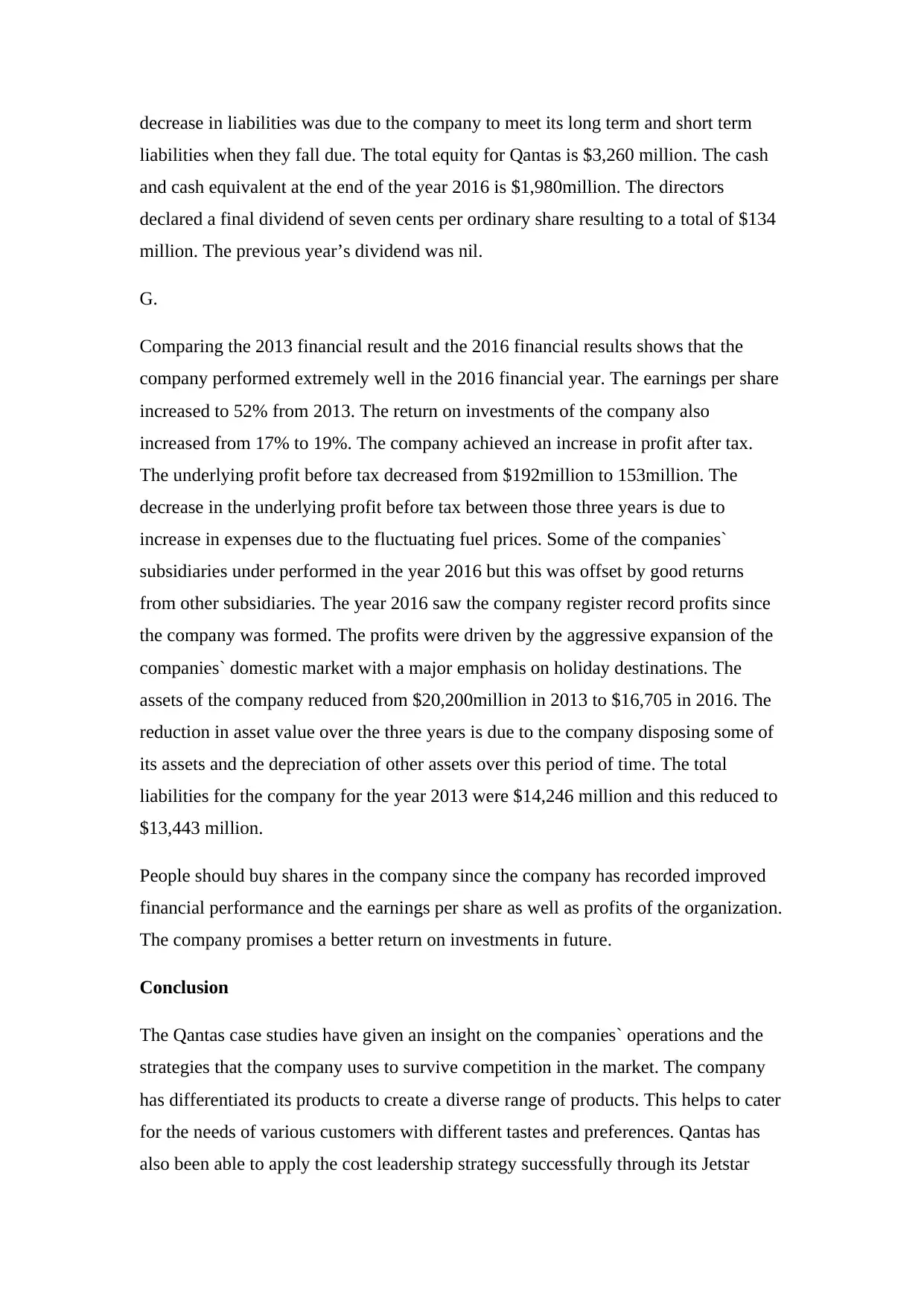
decrease in liabilities was due to the company to meet its long term and short term
liabilities when they fall due. The total equity for Qantas is $3,260 million. The cash
and cash equivalent at the end of the year 2016 is $1,980million. The directors
declared a final dividend of seven cents per ordinary share resulting to a total of $134
million. The previous year’s dividend was nil.
G.
Comparing the 2013 financial result and the 2016 financial results shows that the
company performed extremely well in the 2016 financial year. The earnings per share
increased to 52% from 2013. The return on investments of the company also
increased from 17% to 19%. The company achieved an increase in profit after tax.
The underlying profit before tax decreased from $192million to 153million. The
decrease in the underlying profit before tax between those three years is due to
increase in expenses due to the fluctuating fuel prices. Some of the companies`
subsidiaries under performed in the year 2016 but this was offset by good returns
from other subsidiaries. The year 2016 saw the company register record profits since
the company was formed. The profits were driven by the aggressive expansion of the
companies` domestic market with a major emphasis on holiday destinations. The
assets of the company reduced from $20,200million in 2013 to $16,705 in 2016. The
reduction in asset value over the three years is due to the company disposing some of
its assets and the depreciation of other assets over this period of time. The total
liabilities for the company for the year 2013 were $14,246 million and this reduced to
$13,443 million.
People should buy shares in the company since the company has recorded improved
financial performance and the earnings per share as well as profits of the organization.
The company promises a better return on investments in future.
Conclusion
The Qantas case studies have given an insight on the companies` operations and the
strategies that the company uses to survive competition in the market. The company
has differentiated its products to create a diverse range of products. This helps to cater
for the needs of various customers with different tastes and preferences. Qantas has
also been able to apply the cost leadership strategy successfully through its Jetstar
liabilities when they fall due. The total equity for Qantas is $3,260 million. The cash
and cash equivalent at the end of the year 2016 is $1,980million. The directors
declared a final dividend of seven cents per ordinary share resulting to a total of $134
million. The previous year’s dividend was nil.
G.
Comparing the 2013 financial result and the 2016 financial results shows that the
company performed extremely well in the 2016 financial year. The earnings per share
increased to 52% from 2013. The return on investments of the company also
increased from 17% to 19%. The company achieved an increase in profit after tax.
The underlying profit before tax decreased from $192million to 153million. The
decrease in the underlying profit before tax between those three years is due to
increase in expenses due to the fluctuating fuel prices. Some of the companies`
subsidiaries under performed in the year 2016 but this was offset by good returns
from other subsidiaries. The year 2016 saw the company register record profits since
the company was formed. The profits were driven by the aggressive expansion of the
companies` domestic market with a major emphasis on holiday destinations. The
assets of the company reduced from $20,200million in 2013 to $16,705 in 2016. The
reduction in asset value over the three years is due to the company disposing some of
its assets and the depreciation of other assets over this period of time. The total
liabilities for the company for the year 2013 were $14,246 million and this reduced to
$13,443 million.
People should buy shares in the company since the company has recorded improved
financial performance and the earnings per share as well as profits of the organization.
The company promises a better return on investments in future.
Conclusion
The Qantas case studies have given an insight on the companies` operations and the
strategies that the company uses to survive competition in the market. The company
has differentiated its products to create a diverse range of products. This helps to cater
for the needs of various customers with different tastes and preferences. Qantas has
also been able to apply the cost leadership strategy successfully through its Jetstar
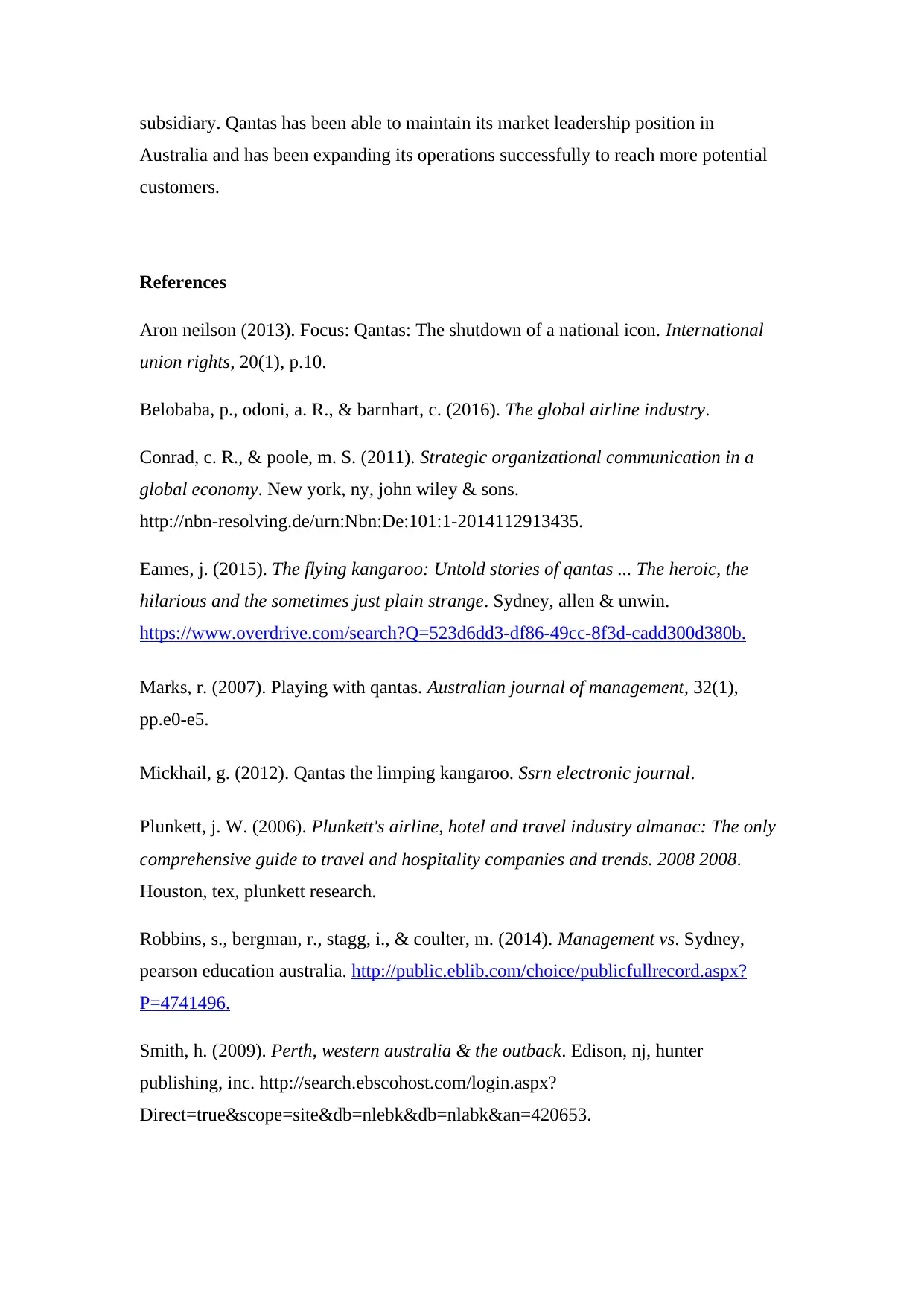
subsidiary. Qantas has been able to maintain its market leadership position in
Australia and has been expanding its operations successfully to reach more potential
customers.
References
Aron neilson (2013). Focus: Qantas: The shutdown of a national icon. International
union rights, 20(1), p.10.
Belobaba, p., odoni, a. R., & barnhart, c. (2016). The global airline industry.
Conrad, c. R., & poole, m. S. (2011). Strategic organizational communication in a
global economy. New york, ny, john wiley & sons.
http://nbn-resolving.de/urn:Nbn:De:101:1-2014112913435.
Eames, j. (2015). The flying kangaroo: Untold stories of qantas ... The heroic, the
hilarious and the sometimes just plain strange. Sydney, allen & unwin.
https://www.overdrive.com/search?Q=523d6dd3-df86-49cc-8f3d-cadd300d380b.
Marks, r. (2007). Playing with qantas. Australian journal of management, 32(1),
pp.e0-e5.
Mickhail, g. (2012). Qantas the limping kangaroo. Ssrn electronic journal.
Plunkett, j. W. (2006). Plunkett's airline, hotel and travel industry almanac: The only
comprehensive guide to travel and hospitality companies and trends. 2008 2008.
Houston, tex, plunkett research.
Robbins, s., bergman, r., stagg, i., & coulter, m. (2014). Management vs. Sydney,
pearson education australia. http://public.eblib.com/choice/publicfullrecord.aspx?
P=4741496.
Smith, h. (2009). Perth, western australia & the outback. Edison, nj, hunter
publishing, inc. http://search.ebscohost.com/login.aspx?
Direct=true&scope=site&db=nlebk&db=nlabk&an=420653.
Australia and has been expanding its operations successfully to reach more potential
customers.
References
Aron neilson (2013). Focus: Qantas: The shutdown of a national icon. International
union rights, 20(1), p.10.
Belobaba, p., odoni, a. R., & barnhart, c. (2016). The global airline industry.
Conrad, c. R., & poole, m. S. (2011). Strategic organizational communication in a
global economy. New york, ny, john wiley & sons.
http://nbn-resolving.de/urn:Nbn:De:101:1-2014112913435.
Eames, j. (2015). The flying kangaroo: Untold stories of qantas ... The heroic, the
hilarious and the sometimes just plain strange. Sydney, allen & unwin.
https://www.overdrive.com/search?Q=523d6dd3-df86-49cc-8f3d-cadd300d380b.
Marks, r. (2007). Playing with qantas. Australian journal of management, 32(1),
pp.e0-e5.
Mickhail, g. (2012). Qantas the limping kangaroo. Ssrn electronic journal.
Plunkett, j. W. (2006). Plunkett's airline, hotel and travel industry almanac: The only
comprehensive guide to travel and hospitality companies and trends. 2008 2008.
Houston, tex, plunkett research.
Robbins, s., bergman, r., stagg, i., & coulter, m. (2014). Management vs. Sydney,
pearson education australia. http://public.eblib.com/choice/publicfullrecord.aspx?
P=4741496.
Smith, h. (2009). Perth, western australia & the outback. Edison, nj, hunter
publishing, inc. http://search.ebscohost.com/login.aspx?
Direct=true&scope=site&db=nlebk&db=nlabk&an=420653.
⊘ This is a preview!⊘
Do you want full access?
Subscribe today to unlock all pages.

Trusted by 1+ million students worldwide
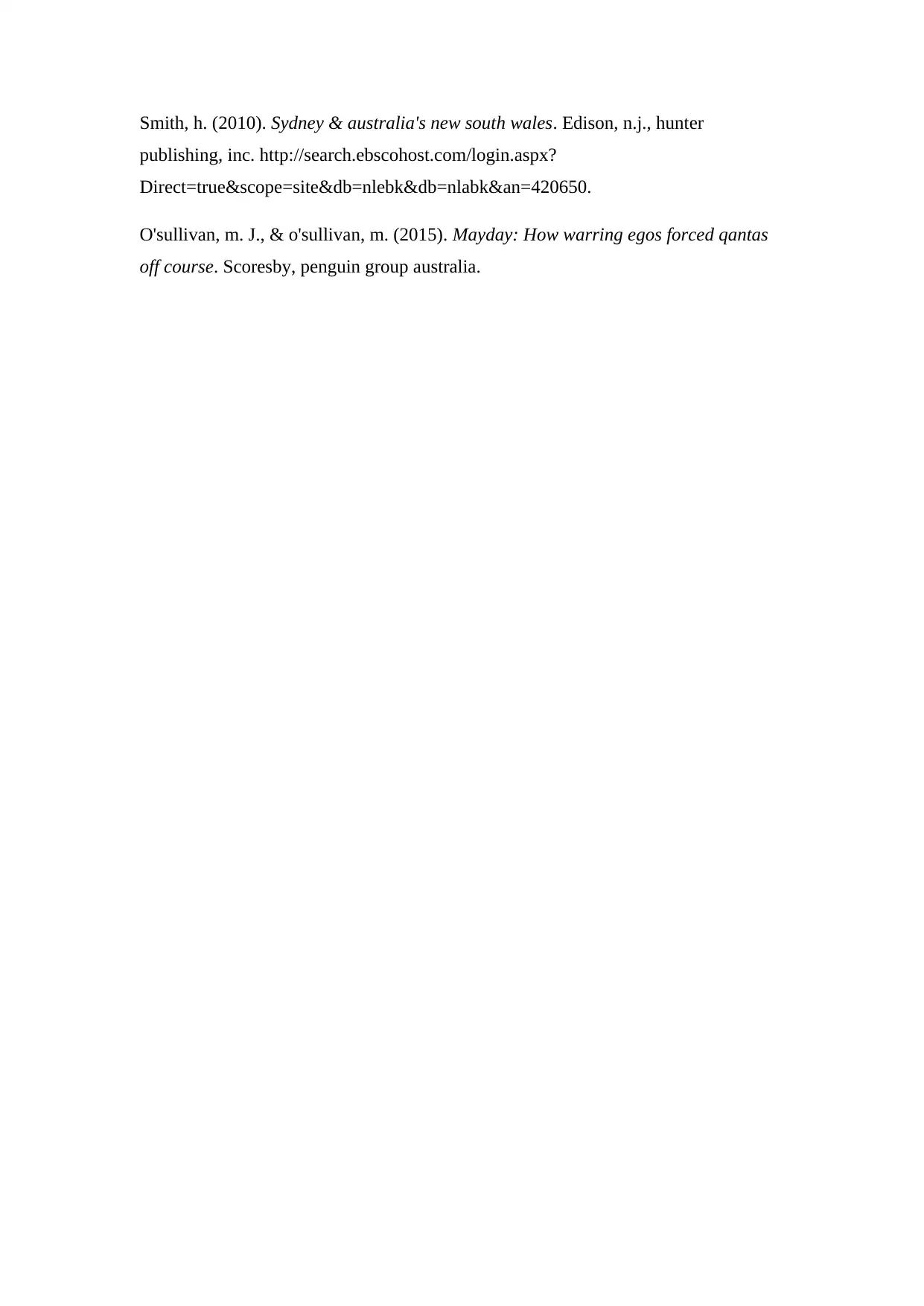
Smith, h. (2010). Sydney & australia's new south wales. Edison, n.j., hunter
publishing, inc. http://search.ebscohost.com/login.aspx?
Direct=true&scope=site&db=nlebk&db=nlabk&an=420650.
O'sullivan, m. J., & o'sullivan, m. (2015). Mayday: How warring egos forced qantas
off course. Scoresby, penguin group australia.
publishing, inc. http://search.ebscohost.com/login.aspx?
Direct=true&scope=site&db=nlebk&db=nlabk&an=420650.
O'sullivan, m. J., & o'sullivan, m. (2015). Mayday: How warring egos forced qantas
off course. Scoresby, penguin group australia.
1 out of 10
Related Documents
Your All-in-One AI-Powered Toolkit for Academic Success.
+13062052269
info@desklib.com
Available 24*7 on WhatsApp / Email
![[object Object]](/_next/static/media/star-bottom.7253800d.svg)
Unlock your academic potential
Copyright © 2020–2025 A2Z Services. All Rights Reserved. Developed and managed by ZUCOL.





